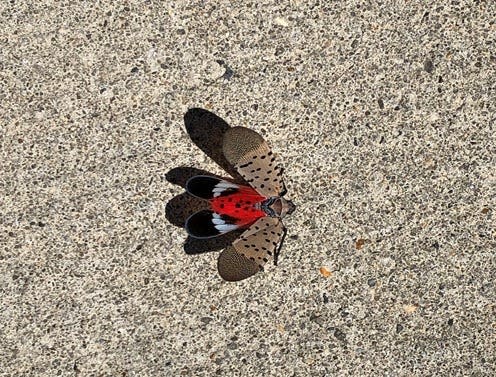Spotted lanternfly season has officially begun. What to know about the invasive creatures
Spotted lanternfly season has officially started and the pesky, brightly colored bugs are popping up across the Lower Hudson Valley.
Since 2020, East Coasters have been stomping, squashing and even vacuuming up spotted lanternflies after the U.S. Department of Agriculture issued a warning for the invasive species and its massive boom across states like New York, New Jersey, Pennsylvania, Delaware and Maryland.
But what makes these creatures such a threat? The New York State Department of Conservation says the insects tend to feed on and deplete maple, walnut and fruit trees, grapevines and over 70 major crops in New York with their piercing, sucking mouthparts.
To prevent massive spotted lanternfly populations from destroying local crops, the U.S. Fish and Wildlife Service has called on residents to stomp, scrape and vacuum spotted lanternflies wherever they see them to help eradicate their spread. The NYSDEC said New York's apple and grape market makes over $350 million every year and has seen some negative impacts from the infestation.
What do spotted lanternflies look like?
According to the New York State Department of Agriculture and Markets, adult spotted lanterflies begin to appear in July and are approximately 1 inch long and a half-inch wide at rest.

Newly hatched spotted lanternflies, or nymphs, can be seen as early as April and until July. They are black with white spots before they turn red. The red nymphs can be seen from July to September.
Nymphs emerge in the spring, typically around April and May, and appear black with white spots. They will turn red before transitioning into the iconic insects that have become a familiar sight to Lower Hudson Valley residents, with muted gray and red wings, black spots and bright red under their wings.
In the fall, adult insects lay 1-inch long eggs in clusters on tree trunks, cars, rocks and almost any other flat surface. They appear smooth and brown with a waxy coating when they are first laid. Older eggs are a deeper brown and scaly.
The state DEC said an infestation is probable if sap is seen oozing from open wounds on tree trunks. This liquid waste, called "honeydew," tends to attract black, sooty mold and could interfere with plant photosynthesis and outdoor fabrics and clothes.
What is being done to control them?
Hanna Birkhead, Assistant Director for the Department of Agriculture and Markets, said the department has worked with NYSDEC, USDA and Cornell Cooperative Extension since January 2018 to study the patterns of the invasive species and has taken "an aggressive approach" to managing its populations in the states.
"The department facilitates an external quarantine that restricts the movement of goods brought into New York from quarantined areas and inspects nursery stock, stone shipments, and commercial transports from those quarantine areas," she said.
Putnam, Rockland and Westchester counties are a few of the "protective zones" that were identified as high-risk areas for spotted lanternfly populations.
"Spotted lanternfly populations will show variability from season to season," Birkhead said. "In areas where spotted lanternfly populations are established, such as the Lower Hudson Valley, residents will continue to observe significant numbers of SLF."
Other high-risk areas include New York City, Long Island, Orange, Dutchess, Sullivan and Ulster counties. Birkhead said people living in these areas no longer need to report or collect samples of the insects.
What can I do?
The state DEC and the USDA encourage residents to kill lanternflies on site, whether that's stomping adults and nymphs, scraping and squashing eggs from tree trunks or cars and even vacuuming them.
Check your belongings before traveling to make sure the insects or eggs have not attached themselves to your objects. Egg masses can be killed by scraping them into a bucket of hot, soapy water or a jar of hand sanitizer.
Westchester County invested in 10 high-powered vacuums last summer to loan to local communities if residents find an infestation in their neighborhood. Forms for the vacuums can be found here, but should only be filled out by municipal employees,
However, those looking to permanently control populations of the species around them should contact Cornell Cooperative Extension's New York State Integrated Pest Management program, which aims to educate residents about the spread of the bugs and how to get rid of them. Check out its Spotted Lanternfly Checklist to see where the insects are most frequently found.
For more information about pest management, contact Brian Eshenaur at 585-753-2561 or bce1@cornell.edu. To alert the Department of Agriculture about an egg mass or major infestation, reach out to spottedlanternfly@agriculture.ny.gov.
This article originally appeared on Rockland/Westchester Journal News: Spotted lanterfly season starts in the Lower Hudson Valley
